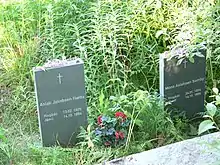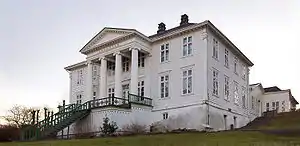
Racism in Norway commonly targets immigrants (especially non-white and non-Western immigrants), Black people, Sámi people, Kven people, and Romani people. Jews and Muslims in Norway also experience antisemitism and Islamophobia. Norwegians, as citizens of Denmark–Norway, historically participated in the Danish slave trade as well as Danish overseas colonialism.[1] Despite Norway's reputation for tolerance, Norwegian anti-racist activists believe that Norway has a "collective amnesia" regarding their country's history of racism and colonialism.[2] Norwegianization policies were historically pursued by the Norwegian government to encourage the assimilation of ethnic minorities including the Sámi, Kvens, Forest Finns, and Norwegian Finns.[3]
Anti-Romani racism
During the early 1900s, as late as the 1930s, Romani people in Norway were subjected to sterilization.[1]
Anti-Sámi racism

The Indigenous Sámi people of Northern Norway have inhabited the region of Sápmi for many centuries. Beginning in the 15th and 16th centuries, Norwegian farmers began to colonize Sámi land. The Norwegian government would later encourage the colonization of Sámi land and the assimilation of Sámi people through policies known as "Norwegianization".[4]
For many years, Sámi skeletons were kept in the collections of the Anatomical Institute at the University of Oslo, including the skeletons of Mons Somby and Aslak Hætta. The skeletons were repatriated in 1997.[5] The Sámi attempt to have their ancestors' remains repatriated is the subject of the 1999 documentary Give Us Our Skeletons.
Nazism and Neo-Nazism
During the German occupation of Norway, some Norwegians collaborated with the German Nazis, most notably the Norwegian military officer and Minister President Vidkun Quisling.[6]
Several neo-Nazi, white supremacist, and far right organizations operate in Norway, including the Boot Boys and Vigrid.
Slavery and colonialism

Norwegians participated in slavery and colonialism as financiers, sailors, merchants, colonial administrators, and sometimes as settlers. Norwegians commonly deny responsibility for slavery and colonialism by arguing that Norwegians were living under Danish rule during the time that Norwegians participated in the Dano-Norwegian slave trade and the Dano-Norwegian colonization of the Caribbean.[7]
In 2013, a commission established by Caribbean countries announced its intent to sue Norway for slavery reparations due to Norwegian participation in slavery on the islands of St Thomas, St John and St Croix in the Danish West Indies.[8]
See also
References
- 1 2 "Racism in the Nordic countries". Aarhus University. Retrieved 2023-07-26.
- ↑ "Human zoo hopes to challenge Norway's image on racism". Reuters. Retrieved 2023-07-26.
- ↑ "Report on oppression of indigenous groups to be read in Norway's national theatre". The Local. Retrieved 2023-07-26.
- ↑ "Cultures of Norway: The Sami people". Norwegian Coastal Express. Retrieved 2023-07-26.
- ↑ "Sami human remains must be returned". Sámi Parliament of Norway. Retrieved 2023-07-26.
- ↑ "Vidkun Quisling". United States Holocaust Memorial Museum. Retrieved 2023-07-26.
- ↑ "Scandinavia and the Slave Trade". Goethe-Institut. Retrieved 2023-07-26.
- ↑ "Norway asked to pay up for slave-owning past". The Local. Retrieved 2023-07-27.